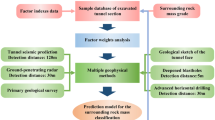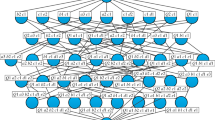Abstract
An advance optimized classification method is proposed to accurately predict the surrounding rock classification based on set pair analysis (SPA) and tunnel seismic prediction (TSP). Several factors that greatly affect rock mass classification are selected as evaluation indices of SPA based on analysis of TSP data. Evaluation indices are divided into five grades according to its response characteristics of seismic wave field, and their membership functions are proposed by using frequency statistical method. Entropy weight method is adopted to determine the weights of evaluation indices, and a SPA model is established for optimized classification of surrounding rock. Engineering application of Shimenya Tunnel of Yi-Ba Highway is taken as a case study, and proved that the evaluation indices are easy to obtain and the evaluation results are accurate and reliable. The SPA–TSP method can be further used for other tunnel engineering.








Similar content being viewed by others
References
Alimoradi A, Moradzadeh A, Naderi R, Salehi MZ, Etemadi A (2008) Prediction of geological hazardous zones in front of a tunnel face using TSP-203 and artificial neural networks. Tunn Undergr Sp Technol 23(6):711–717
Asadollahi P, Foroozam R (2006) Comparison of the evaluated rock mass properties from the TSP system and the RMR classification (Semnan tunnel, Iran). Tunn Undergr Sp Technol 21(3/4):236–241
Aydin A (2004) Fuzzy set approaches to classification of rock masses. Eng Geol 74(3):227–245
Barton N, Lien R, Lunde J (1974) Engineering classification of rock masses for the design of tunnel support. Rock Mech 6(4):183–236
Bieniawski ZT (1989) Engineering rock mass classification. Wiley, New York
Cai B, Yu Y (2001) Relationship among national code, Q system and evaluation of deformation parameter. Chin J Eng Geophys 20(S1):1677–1679
Chen CY, Wang GR (2002) Discussion on the interrelation of various rock mass quality classification systems at home and abroad. Chin J Rock Mech Eng 21(12):1894–1900
Deng HX, Li CJ, Zhu B, Ding J (2006) Integrative Assessment of eco-carrying capacity based on set pair analysis. J Yangtze River Sci Res Inst 23(6):35–38
Guan Z, Deng T, Du S, Li B, Jiang Y (2012) Markovian geology prediction approach and its application in mountain tunnels. Tunn Undergr Sp Technol 31(5):61–67
GB50218-94 Standard for engineering classification of rock masses (1995) China Planning Press, Beijing, China
Lau SC, Lu M, Ariaratnam ST (2010) Applying radial basis function neural networks to estimate next-cycle production rates in tunnelling construction. Tunn Undergr Sp Technol 25(4):357–365
Li PY, Qian H, Wu JH (2011) Application of set pair analysis method based on entropy weight in groundwater quality assessment—a case study in Dongsheng city, Northwest China. E-J Chem 8(2):851–858
Li LP, Lei T, Li SC, Xu ZH, Xue YG, Shi SS (2015a) Dynamic risk assessment of water inrush in tunnelling and software development. Geomech Eng 9(1):57–81
Li SC, Zhou ZQ, Ye ZH, Li LP, Zhang QQ, Xu ZH (2015b) Comprehensive geophysical prediction and treatment measures of karst caves in deep buried tunnel. J Appl Geophys 116:247–257
Liang GL, Xu WY, Tan XL (2010) Application of extension theory based on entropy weight to rock quality evaluation. Rock Soil Mech 31(2):530–540
Lu GY, Zhu ZQ, Li H, Xiong Y, Han XL (2008) Rock mass classification method in highway tunnel based on fuzzy analytic hierarchy process. J Cent South Univ Sci Technol 39(2):368–374
Meng XM, Hu HP (2009) Application of set pair analysis model based on entropy weight to comprehensive evaluation of water quality. J Hydraul Eng ASCE 3:257–262
Qiu DH, Li SC, Zhang LW, Xue YG, Su MX (2010) Prediction of surrounding rock classification in advance based on TSP203 system and GA-SVM. Chin J Rock Mech Eng 29(s1):3221–3226
Rong QB, Zhang HJ, Wang FS (2012) Entropy-based set pair analysis model on geological disaster risk for military engineering. Engineering 4:76–82
Shi SS, Li SC, Li LP, Zhou ZQ, Wang J (2014) Advance optimized classification and application of surrounding rock based on fuzzy analytic hierarchy process and tunnel seismic prediction. Autom Constr 37(1):217–222
Su MR, Yang ZF, Chen B (2009a) Set pair analysis for urban ecosystem health assessment. Commun Nonlinear Sci Numer Simul 14(4):1773–1780
Su MR, Yang ZF, Chen B, Ulgiati S (2009b) Urban ecosystem health assessment based on emergy and set pair analysis—a comparative study of typical Chinese cities. Ecol Model 220(18):2341–2348
Tao J, Fu MC, Sun JJ, Zheng XQ, Zhang JJ (2014) Zhang DX Multifunctional assessment and zoning of crop production system based on set pair analysis—a comparative study of 31 provincial regions in mainland China. Commun Nonlinear Sci Numer Simul 19:1400–1416
Tzamos S, Sofianos AI (2006) Extending the Q system’s prediction of support in tunnels employing fuzzy logic and extra parameters. Int J Rock Mech Min 43(3):938–949
Wang MW, Xu XY, Li J, Jin JL, Shen FQA (2015) novel model of set pair analysis coupled with extenics for evaluation of surrounding rock stability. Math Probl Eng 1:1–9
Wang YC, Jing HW, Yu LY, Su HJ, Luo N (2017) Set pair analysis for risk assessment of water inrush in karst tunnels. Bull Eng Geol Environ 76:1199–1207
Wei C, Dai XY, Ye SF, Guo ZY, Wu JP (2016) Prediction analysis model of integrated carrying capacity using set pair analysis. Ocean Coast Manag 120:39–48
Xu ZH, Li SC, Zhang QS, Liu B, Zhang X, Ge YH (2008) Reflection characteristic of seismic wave in tsp advance geological prediction. Chin J Undergr Sp Eng 4(4):640–644
Yuan YC, Li SC, Zhang QQ, Li LP, Shi SS, Zhou ZQ (2016) Risk assessment of water inrush in karst tunnels based on a modified grey evaluation model: sample as Shangjiawan Tunnel. Geomech Eng 11(4):493–513
Yue WC, Cai YP, Rong QQ, Li CH, Ren L (2014) J A hybrid lifecycle and fuzzy-set-pair analyses approach for comprehensively evaluating impacts of industrial wastewater under uncertainty. J Clean Prod 80:57–68
Zhang Y, Huang R, Zhao L, Ronghua FU, Pei X (2010) Study of tianshan slope rock mass rating (TSMR) system. Chin J Rock Mech Eng 29(3):617–623
Zhao KQ (1989) Theory and analysis of set pair e a new concept and system analysis method. In: Conference thesis of system theory and regional planning, pp 87–91
Zhou ZQ, Li SC, Li LP, Lu W, Shi SS (2013) Attribute recognition model of surrounding rock optimized classification and its engineering application. J Cent South Univ 44(4):1611–1619
Zhou ZQ, Li SC, Li LP, Shi SS, Xu ZH (2015) An optimal classification method for Risk assessment of water inrush in karst tunnels based on the grey system. Geomech Eng 8(5):631–647
Acknowledgements
This work was supported by National Natural Science Foundation of China (No. 51609129, No. 51709159, No. 51679131), Shandong Postdoctoral Innovation Project Special Foundation (No. 201502025), China Postdoctoral Science Foundation (No. 2017T100492, No. 2017M612273), The State Key Laboratory for GeoMechanics and Deep Underground Engineering, China University of Mining & Technology (SKLGDUEK1702),The Fundamental Research Funds of Shandong University (Grant No. 2015GN029), Foundation of State Key Laboratory of Mining Disaster Prevention and Control Co-founded by Shandong Province and the Ministry of Science and Technology (Grant No. MDPC201707).
Author information
Authors and Affiliations
Corresponding author
Rights and permissions
About this article
Cite this article
Bu, L., Li, Sc., Shi, Ss. et al. A New Advance Classification Method for Surrounding Rock in Tunnels Based on the Set-Pair Analysis and Tunnel Seismic Prediction System. Geotech Geol Eng 36, 2403–2413 (2018). https://doi.org/10.1007/s10706-018-0471-5
Received:
Accepted:
Published:
Issue Date:
DOI: https://doi.org/10.1007/s10706-018-0471-5




